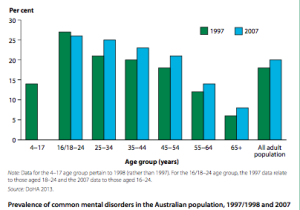The nature of the problem
Mental health problems and illnesses include a wide range of mental disorders, the most prevalent being: anxiety, affective disorders (such as depression), and substance-use disorders (such as alcohol dependency). Mental health problems and illnesses can range in severity. Severity of mental health problems or illnesses is determined by diagnosis, intensity and duration of the symptoms, and the degree of disability. Mental health problems and illnesses have a great impact on people’s ability to function socially, emotionally and cognitively. People with mental health problems and illnesses are often isolated and experience stigma because of their disorder.
Extent of the problem (trends)
2-3% of Australians have severe mental health problems or illnesses. 4-6% have moderate and 19-2% have mild mental health problems and illnesses. While these numbers are not large, 45% of Australians between 15 and 85 reported suffering from a mental health problem or illness in their lifetime, with 1 in 5 experiencing a mental health problem in the last 12 months. Prevalence of mental health problems and illnesses is higher amongst males and in people aged 16-24 and roughly 14% of children suffer form a clinically significant mental health problem or illness. The overall trend in mental health problems and illnesses is a slight incline as seen in the graph on the right.
Mental health problems and illnesses have the third most costly disease in Australia, and are responsible for 13% of the total burden of disease.
Mental health problems and illnesses affect lives. Affective or mood disorders greatly affect a person’s life at home, work, socially, and relationally. People with anxiety often report experiencing high levels of psychological distress. People with psychotic disorders are less able to care for themselves and feel socially isolated. People with mental health problems and disorders are 3.5 times more likely to be suicidal.
Comorbidity is high amongst people suffering from mental health problems and illnesses. 11.5% of people living with a disability have a mental health disorder or illness, and 12% of people 16-85 reported having a mental health problem or illness as well as a physical disability.
Risk factors and protective factors
Risk factors for mental health problems and illnesses include: genetics, chemical imbalances in the body, hard life experiences, poor up-brining or family relationships, and drug use.
Protective factors for mental health include: positive social life, positive relationships, positive sense of self, self-control, good support networks, and resilience.
The sociocultural, socioeconomic and environmental determinants
Sociocultural determinants of mental health include: family, peers, media, culture and religion. Australia’s media and society have worked hard to reduce the stigma around mental health disorders and illnesses through advertising and other media programs. Community groups such as Beyond Blue also help to raise awareness of mental health problems and illnesses around Australia. Even the National Rugby League are chipping in to break down the characteristic male who has no emotion. People brought up in families that are broken or dysfunctional have higher rates of mental health problems and illnesses, as are people with a family history of mental health problems.
Socioeconomic determinants of mental health include: education, employment and income, Mental health problems and illnesses are commonly associated with economic disadvantage, unemployment or under-employment, homelessness and reduced productivity. There is also a link between poor up-bringing and lower socioeconomic status, including homelessness, where further harsh treatment often results. Furthermore, people who work in high stress jobs are more likely to suffer a mental health problem or illness.
Environmental determinants of mental health include geographic location and access to health services and technology. People living in rural areas have less access to mental health services and also have a culture of a tough male who does not suffer emotionally or mentally.
Groups at risk
Groups at risk of mental health problems and illnesses include:
- Males
- ATSI males
- People who have suffered from traumatic life experiences
- People with a family history of mental health problems and illnesses
- People of low socioeconomic status
- Young people (16-24) particularly males



